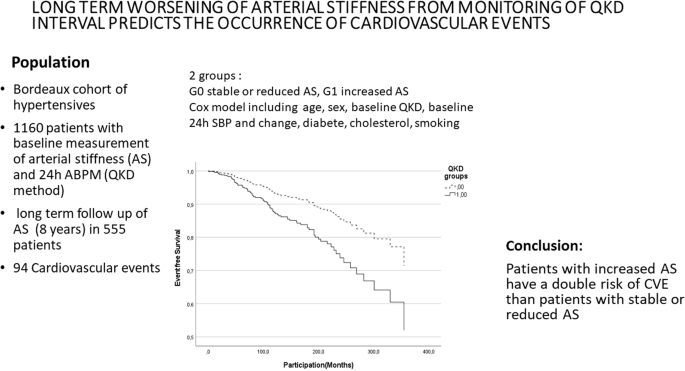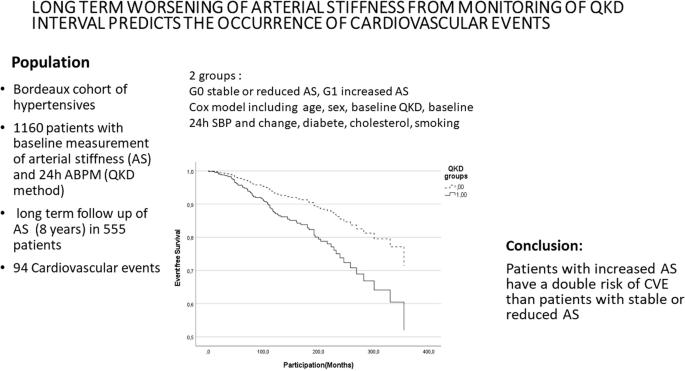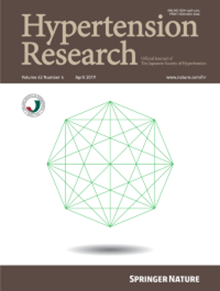通过监测 QKD 间期,动脉僵化的长期恶化可预测心血管事件的发生。
IF 4.3
2区 医学
Q1 PERIPHERAL VASCULAR DISEASE
引用次数: 0
摘要
动脉僵化是不同人群心血管事件的独立预测指标。通过控制主要的心血管风险因素,动脉僵化似乎可以得到缓解,但个体差异很大。到目前为止,有关动脉僵化变化对预后的重要性的数据还很少。我们在一组高血压患者中测试了用 QKD 方法评估的动脉僵化变化对心血管事件发生率的影响。QKD100-60 的变化按基线值与最后一次随访值之间的差值计算。患者被分为 QKD100-60 稳定或增加的 0 组和 QKD100-60 减少(动脉僵化增加)的 1 组。这两组患者的预后采用 Cox 模型进行分析,该模型包括年龄、基线 QKD100-60、24 h SBP(基线和变化)、首次记录与最后一次记录之间的延迟、性别、糖尿病、吸烟和高胆固醇血症。我们共纳入了 555 名在基线和随访期间进行 24 小时动态血压和 QKD 测量的本质性高血压患者。随访时间为(12.28 ± 7.38)年,基线与最后一次记录之间的平均时间为(8.86 ± 6.48)年。共发生 94 起心血管事件。与动脉僵化稳定或降低的人群相比,动脉僵化增加的人群发生心血管事件的风险增加了一倍,这与其他因素(包括 24 h SBP 的变化)无关。本文章由计算机程序翻译,如有差异,请以英文原文为准。


Long term worsening of arterial stiffness from monitoring of QKD interval predicts the occurrence of cardiovascular events
Arterial stiffness is an independent predictor of cardiovascular events in different populations. Destiffening appears to be possible through the control of the main cardiovascular risk factors, with however important individual variations. There are so far too few data available on the prognostic importance of changes in arterial stiffness. We tested the consequences of changes in arterial stiffness assessed with the QKD method on the incidence of cardiovascular events in a cohort of hypertensive patients. The change of QKD100-60 was calculated as the difference between baseline and last follow-up value. Patients were classified as group 0 with stable or increased QKD100-60 and group 1 with decreased QKD100-60 (increased arterial stiffness). The prognostic of these two groups was analysed with a Cox model including age, baseline QKD100-60, 24 h SBP (baseline and change), delay between first and last recording, sex, diabetes, smoking, and hypercholesterolemia. We included 555 essential hypertensive patients with 24 h ambulatory measurement of BP and QKD at baseline and follow-up. The follow-up period was 12.28 ± 7.38 years with an average time between baseline and last recording of 8.86 ± 6.48 years. 94 cardiovascular events occurred. The group with increased arterial stiffness shows the double risk of occurrence of cardiovascular event than the group with stable or reduced arterial stiffness independently of other factors including changes in 24 h SBP.
求助全文
通过发布文献求助,成功后即可免费获取论文全文。
去求助
来源期刊

Hypertension Research
医学-外周血管病
CiteScore
7.40
自引率
16.70%
发文量
249
审稿时长
3-8 weeks
期刊介绍:
Hypertension Research is the official publication of the Japanese Society of Hypertension. The journal publishes papers reporting original clinical and experimental research that contribute to the advancement of knowledge in the field of hypertension and related cardiovascular diseases. The journal publishes Review Articles, Articles, Correspondence and Comments.
 求助内容:
求助内容: 应助结果提醒方式:
应助结果提醒方式:


